Take a seat first, neighbors. Let’s closely take a look at the “Child Seat Law” first.
Hold your horses! Or your car seats.
Don’t buy those car seats just yet and read these provisions from Republic Act No. 11229 first before doing anything drastic. Remember the plastic barriers for motorcycles?
With the implementation of RA 11229 today comes a whole lot of confusion on not just its implementation but also on what it really says.
RA 11229 or “An Act Providing for the Special Protection of Child Passengers in Motor Vehicles and APPROPRIATING FUNDS (yes, the last part is included in the bill’s name) is defined as “the policy of the State to ensure the safety of children while being transported in any form of motor vehicle” (take note: ANY FORM OF MOTOR VEHICLE but please read further).
Let’s take a closer look:
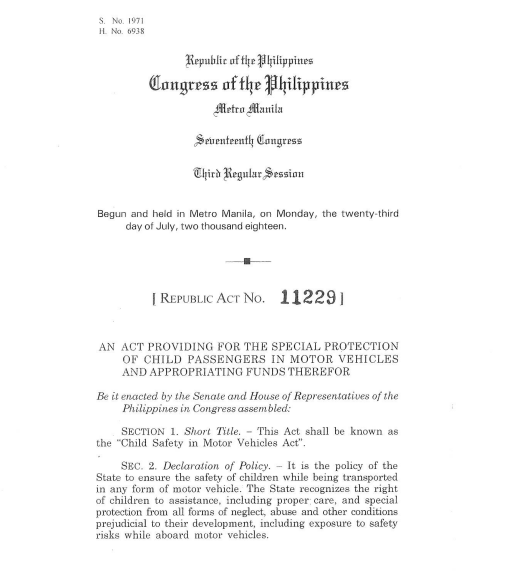
Okay, so let’s call it the “Child Safety in Motor Vehicles Act” from now on.
Who here also got nervous upon reading “and appropriating funds therefor…”? Anyway…
More on Section 2:
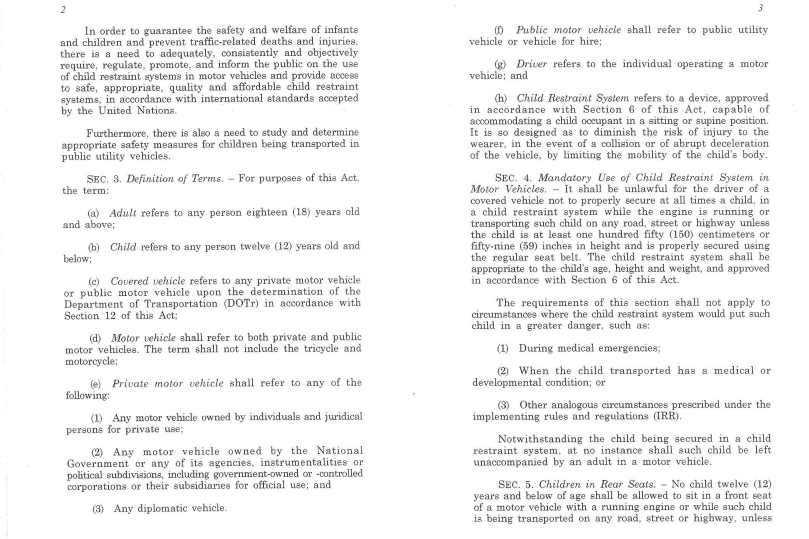
Please check out these provisions from the said bill:
We see “in accordance with international standards accepted by the United Nations.” Okay.
(a) CHILD refers to any person twelve (12) years old and below.
(d) Motor vehicle shall refer TO BOTH PRIVATE AND PUBLIC motor vehicles. THE TERM SHALL NOT INCLUDE THE TRICYCLE AND MOTORCYCLE.
(h) CHILD RESTRAINT SYSTEM refers to a device, APPROVED in accordance with Section 6 of this Act (let us take a look at that later), capable of accommodating a child occupant IN A SITTING OR SUPINE POSITION.
*The supine position means lying horizontally with the face and torso facing up, as opposed to the prone position, which is face down. (thank you, Wikipedia)
Section 4: Mandatory Use of Child Restraint System in Motor Vehicles:
Notables:
“While the engine is running or transporting such child on any road, street or highway…”
“Unless the child is at least 150 centimeters (4’9 feet) or 59 inches in height (same, 4 feet and 9 inches — not sure why they didn’t just say this since we use this more often) in height and is properly secured using the regular seat belt.”
Exemptions to this are:
1. Medical Emergencies
2. When the child being transported has a medical or developmental condition
3. Other analogous circumstances prescribed under the IRR (more about the IRR later)
Section 5: Children in Rear Seats
No child 12 years old and below shall be allowed to sit in a front seat with the engine running.
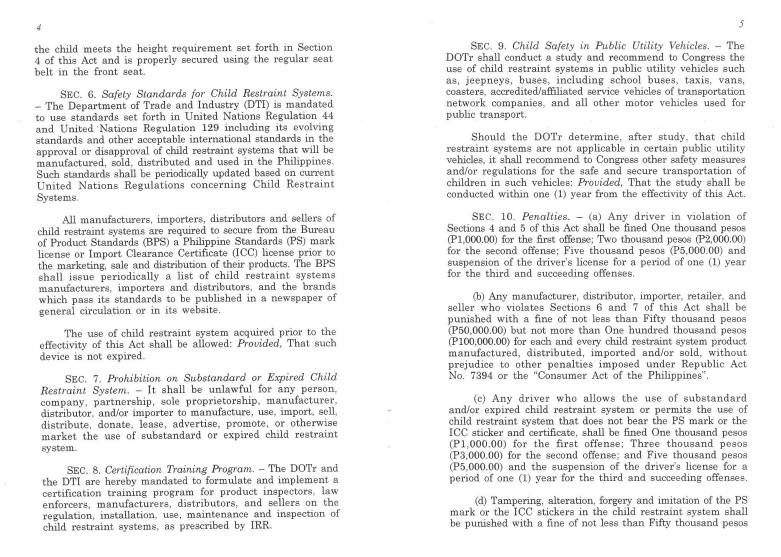
Section 6: Safety Standards for Child Restraint Systems
The Department of Trade and Industry (DTI) is mandated to use standards set forth in United Nations Regulation 44 and United Nations Regulation 129 including its evolving standards and other acceptable international standards IN THE APPROVAL or DISAPPROVAL of child restraint systems that will be MANUFACTURED, SOLD, DISTRIBUTED and USED in the Philippines.
Please see UN Regulation 44 here:
Child restraint systems approved under UN Regulation 44 are classified into five weight groups. For
children up to 13 kg they are rearward facing. For the groups up to 18 kg these child restraint
systems have integrated harness system or impact shield. The groups for heavier children up to 36
kg mostly use the vehicle’s safety belt for restraining.
Please see UN Regulation 129 here:
https://unece.org/DAM/trans/doc/2015/wp29grsg/GRSG-108-14e.pdf
We did not see any provisions related to height. But please feel free to correct us as we may have missed that.
So basically, Section 6 says that car seat manufacturers, importers, distributors and sellers are required to secure approval from the Bureau of Product Standards.
“The BPS shall issue periodically a list of child restraint systems manufacturers, importers and distributors, and the brands which pass its standards to be published in a newspaper of general circulation or in its website.”
So it may be wise to wait for this list before purchasing one (or two, or three).
It would be wise for the government also to release this list asap (if they have, please let us know so we can update this post).
Section 9: Child Safety in Public Utility Vehicles
It says the DOTr shall conduct a study regarding this and provide Congress with their recommendations. RA 11299 was approved in 2018. Not sure if recommendations have already been given.
PENALTIES:
First Offense – P1,000
Second Offense – P2,000
Third and Succeeding Offenses – P5,000 and one year suspension of driver’s license
*drivers using sub-standard child restrain systems (those without ICC or PS clearance/mark)) will also be fined the same as above
*those tampering or forging PS and/or ICC stickers will also be fined with not less than P50,000
Manufacturers of sub-standard child restraint systems will also be fined.
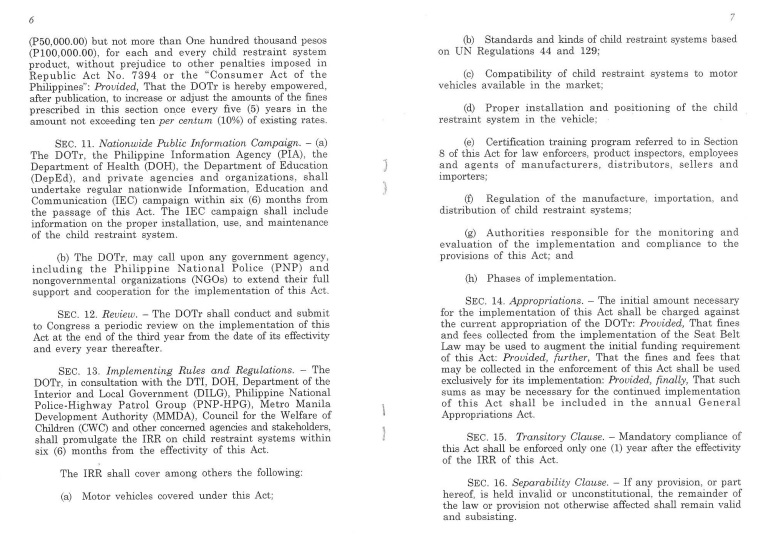
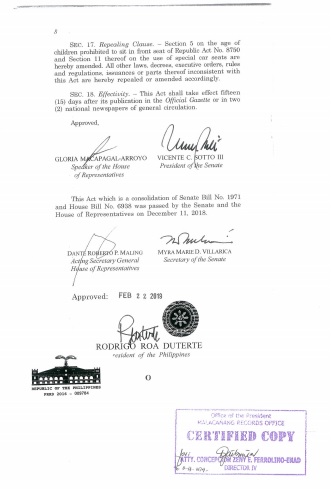
So there you go, neighbors. Better to understand everything first before we complain or before we buy those car seats.
Yes to safety but YES as well to a more detailed information about the law.
Stay safe out there, neighbors!




Recent Comments